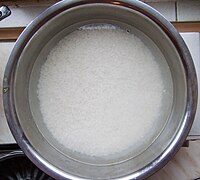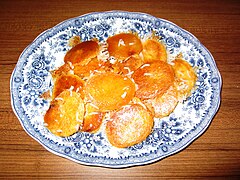Iranian cuisine
| Part of a series on the |
| Culture of Iran |
|---|
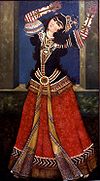 |
|
|

Iranian cuisine is the culinary traditions of Iran. Due to the historically common usage of the term "Persia" to refer to Iran in the Western world,[2][3][4] it is alternatively known as Persian cuisine, despite Persians being only one of a multitude of Iranian ethnic groups who have contributed to Iran's culinary traditions.[a]
Iran has a variety of 2,500 types of traditional food, one of the richest in the world.
Typical Iranian main dishes are combinations of rice with meat, vegetables and nuts. Herbs are frequently used, along with fruits such as plums, pomegranates, quince, prunes, apricots and raisins. Characteristic Iranian spices and flavourings such as saffron, cardamom, and dried lime and other sources of sour flavoring, cinnamon, turmeric and parsley are mixed and used in various dishes.
Outside of Iran, a strong presence of Iranian cuisine can be found in cities with significant
History
Among the writings available from the
Ancient Persian philosophers and physicians have influenced the preparation of Iranian foods to follow the rules of the strengthening and weakening characteristics of foods based on the Iranian traditional medicine.[19]
Historical Iranian cookbooks
Although the Arabic cookbooks written under the rule of the Abbasid Caliphate—one of the Arab caliphates which ruled Iran after the Muslim invasion—include some recipes with Iranian names, the earliest surviving classical cookbooks in Persian are two volumes from the Safavid period. The older one is entitled "Manual on cooking and its craft" (Kār-nāmeh dar bāb e tabbāxī va sanat e ān) written in 927/1521 for an aristocratic patron at the end of the reign of Ismail I. The book originally contained 26 chapters, listed by the author in his introduction, but chapters 23 through 26 are missing from the surviving manuscript. The recipes include measurements for ingredients—often detailed directions for the preparation of dishes, including the types of utensils and pots to be used—and instructions for decorating and serving them. In general, the ingredients and their combinations in various recipes do not differ significantly from those in use today. The large quantities specified, as well as the generous use of such luxury ingredients as saffron, suggest that these dishes were prepared for large aristocratic households, even though in his introduction, the author claimed to have written it "for the benefit of the nobility, as well as the public."
The second surviving Safavid cookbook, entitled "The substance of life, a treatise on the art of cooking" (Māddat al-ḥayāt, resāla dar ʿelm e ṭabbāxī), was written about 76 years later by a chef for
Staple foods
Rice
The usage of rice, at first a specialty of the Safavid Empire's court cuisine, evolved by the end of the 16th century CE into a major branch of Iranian cookery.[21] Traditionally, rice was most prevalent as a major staple item in northern Iran and the homes of the wealthy, while bread was the dominant staple in the rest of the country.
Varieties of rice in Iran include gerde, domsia (literally meaning black-tail, because it is black at one end), champa, doodi (smoked rice), Lenjan (from Lenjan County), Tarom (from Tarom County), and anbarbu.
The following table includes three primary methods of cooking rice in Iran.
| Method | Description |
|---|---|
| Polow and chelow | Chelow is plain rice served as an accompaniment to a stew or kebab, while polow is rice mixed with something. They are, however, cooked in the same way. Rice is prepared by soaking in salted water and then boiling it. The parboiled rice (called chelow) is drained and returned to the pot to be steamed. This method results in exceptionally fluffy rice with the rice grains separated and not sticky. A golden crust called tahdig or tadig is created at the bottom of the pot using a thin layer of bread or potato slices. Often, tahdig is served plain with only a rice crust. Meat, vegetables, nuts, and fruit are sometimes added in layers or mixed with the chelow and then steamed. When chelow is in the pot, the heat is reduced, and a thick cloth or towel is placed under the pot lid to absorb excess steam.
|
| Kateh | Rice that is cooked until the water is absorbed completely. It is the traditional dish of Gilan Province .
|
| Dami | Rice that is cooked almost the same as kateh, but at the start, ingredients that can be cooked thoroughly with the rice (such as grains and beans) are added. While making kateh, the heat is reduced to a minimum until the rice and other ingredients are almost cooked. If kept long enough on the stove without burning and over-cooking, dami and kateh can also produce tahdig. A special form of dami is tachin, which is a mixture of yogurt, chicken (or lamb), and rice, plus saffron and egg yolks. |
-
Iranian-style rice-cooking
-
Soaking rice in a pot
-
Using potatoes astahdigin chelow-style rice-cooking
-
Potatotahdig
-
Tahdig of lavashbread
Bread
Second only to rice is the production and use of wheat. The following table lists several forms of flatbread and pastry bread commonly used in Iranian cuisine.
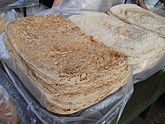 |
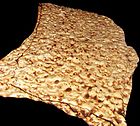 |
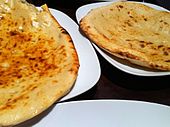 |
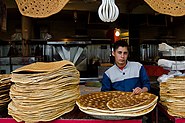 |
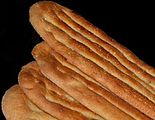 |
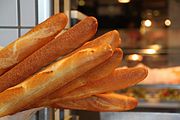 |
 |
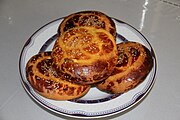 |
Fruits and vegetables
The
Vegetables such as
.Fruit dolma is probably a specialty of Iranian cuisine. The fruit is first cooked, then stuffed with meat, seasonings, and sometimes tomato sauce. The dolma is then simmered in meat broth or ascallions sweet-and-sour sauce.[26]
Verjuice, a highly acidic juice made by pressing unripe grapes or other sour fruit, is used in various Iranian dishes.[27] It is mainly used within soup and stew dishes, but also to simmer a type of squash dolma. Unripe grapes are also used whole in some dishes such as khoresh-e ghooreh (lamb stew with sour grapes). As a spice, verjuice powder (pudr-e ghooreh) is sometimes reinforced by verjuice and then dried.
Typical spices

Advieh or chāshni refers to a wide variety of pungent vegetables and dried fruits that are used in Iranian cuisine to flavor food.
One of the traditional and most widespread Iranian spices is saffron, derived from the flower of Crocus sativus. Rose water, a flavored water made by steeping rose petals in water, is also a traditional and common ingredient in many Iranian dishes.
Persian hogweed (golpar), which grows wild in the humid mountainous regions of Iran, is used as a spice in various Iranian soups and stews. It is also mixed with vinegar into which broad beans are dipped before eating.
Some other common spices are cardamom, made from the seeds of several Elettaria and Amomum plants; shevid, an annual herb in the celery family Apiaceae; mahleb, an aromatic spice made from the seeds of Prunus mahaleb; and limu amani, dried lime.
There are also several traditional combinations of spices, two of which are arde (Tahini), made from toasted ground hulled sesame seeds, and delal sauce, made of heavily salted fresh herbs such as cilantro and parsley.
Typical food and drinks
Typical Iranian cuisine includes a wide variety of dishes, including several forms of kebab, stew, soup, and pilaf dishes, as well as various salads, desserts, pastries, and drinks.
Main course
Kebab
In Iran, kebabs are served either with rice or
The following table lists several forms of kebab used in Iranian cuisine.
 |
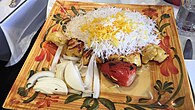 |
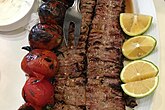 |
Mazenderan , marinated in a paste of crushed walnuts, pomegranate juice, and olive oil.
|
 |
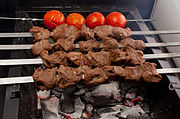 |
 |
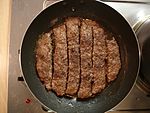 |
 |
Stew
Khoresh is an Iranian form of stew, which is usually accompanied by a plate of white rice. A khoresh typically consists of herbs, fruits, and meat pieces, flavored with tomato paste, saffron, and pomegranate juice. Other non-khoresh types of stew such as dizi are accompanied by bread instead of rice.
Several Iranian stew dishes are listed within the following table.
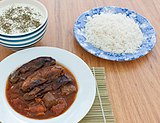 |
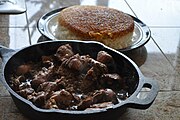 |
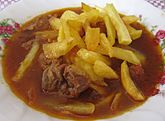 |
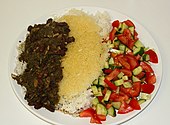 |
 |
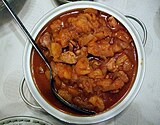 |
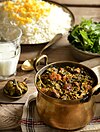 |
 |
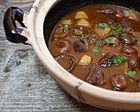 |
Baqala Qatoq: Gilak stew with fava beans , dill, and eggs.
|
 |
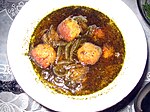 |
| Khoresh-e Bamieh: Okra and meat stew. | Khoresh-e Kadu: Stewed zucchini and meat. |
Soup and āsh
There are various forms of soup in Iranian cuisine, including sup e jow (
The following table lists a number of soup and āsh dishes in Iranian cuisine.
 |
 |
Sirabi: Tripe soup; also known as sirab shirdun.[42]
|
 |
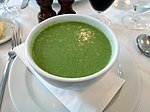 |
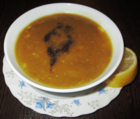 |
Āsh-e Reshte : Noodle thick soup.
|
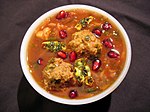 |
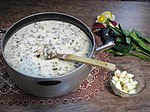 |
Kalle Joosh: Kashk thick soup.
|
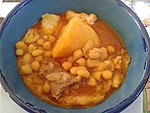 |
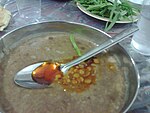 |
Polow and dami
Apart from dishes of rice with kebab or stew, there are various rice-based Iranian dishes cooked in the traditional methods of polow and dami.
Polow is the Persian word for pilaf and it is also used in other Iranian languages, in the English language it may have variations in spelling. A polow dish includes rice stuffed with cuts of vegetables, fruits, and beans, usually accompanied by either chicken or red meat. Dami dishes are similar to polow in that they involve various ingredients with rice, however they are cooked using the dami method of cooking the dish all in one pot.
The following are a number of traditional Iranian rice-based dishes:
 |
 |
Albalu Polo: Rice with sour cherries and slices of chicken or red meat. | 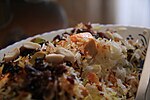 |
Shirin Polo: Rice with sweet carrots, raisins, and almonds.[45]
|
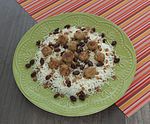 |
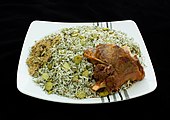 |
lima beans.[48]
|
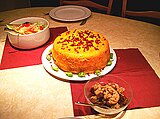 |
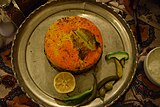 |
 |
Other
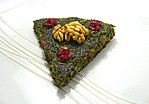 |
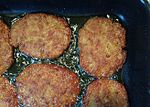 |
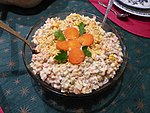 |
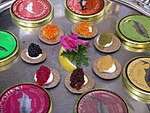 |
 |
 |
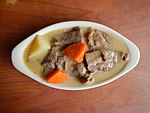 |
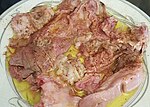 |
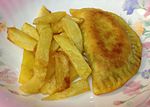 |
Sosis إandari : Traditional sausage with onion, tomato paste, and chili pepper.
|
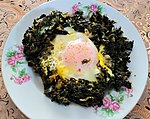 |
Sirabij: A type of garlic omelette. |
Gondi: Iranian Jewish dish of meatball .
|
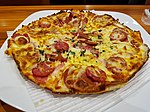 |
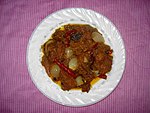 |
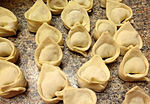 |
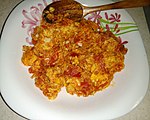 |
 |
 |
ancient Persia and was introduced worldwide in the 16th century.
|
Appetizers
Torshi : Mixed pickles salad.
|
 |
 |
 |
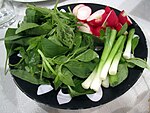 |
Zeytun Parvardeh: Olives in a paste made of pomegranate, walnut and garlic.[49]
|
Mirza Qasemi : Grilled eggplant with egg, garlic and tomato.
|
Kashk-e Bademjan : Mixture of kashk, eggplant and mint.
|
Desserts
In 400 BC, the ancient Iranians invented a special chilled food, made of
The following is a list of several Iranian desserts.
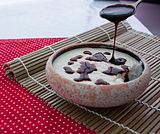 |
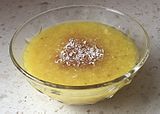 |
 |
Bastani-e Zaferani : Saffron ice cream.
|
 |
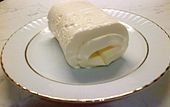 |
 |
Snacks
Cookies appear to have their origins in 7th-century Iran, shortly after the use of sugar became relatively common in the region.[54] There are numerous traditional native and adopted types of snack food in modern Iran, of which some are listed within the following table.
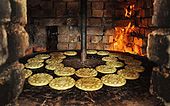 |
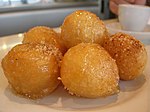 |
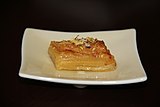 |
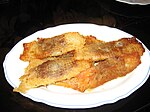 |
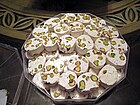 |
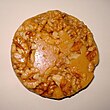 |
Sohan Asali: Brittle candy with honey.
|
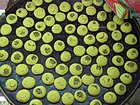 |
 |
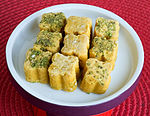 |
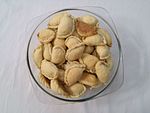 |
 |
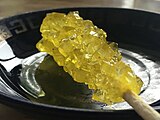 |
 |
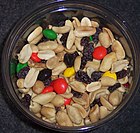 |
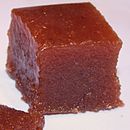 |
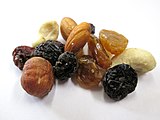 |
Gush-e Fil: Dough topped with pistachios powdered sugar .
|
 |
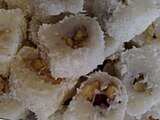 |
Drinks

Iran is one of the world's major tea producers,

Iran's traditional
The following table lists several Iranian cold beverages.
Doogh: Cold yogurt drink, often made with salt, pepper, and other spices.
|
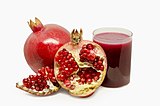 |
ice cream.[78]
|
 |
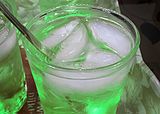 |
distilled alcoholic beverage .
|
Sharbat : Cold and sweet drink made of fruits or flower petals.
|
 |
Regional Iranian cuisine
Azerbaijani cuisine
The
Balochi cuisine
Meat and dates are the main ingredients in the cuisine of Iran's southeastern region of
Caspian cuisine
The southern coast of the
Kurdish cuisine
The
Southern Iranian cuisine
The food of southern Iran is typically spicy. and is made of ground meat, cracked wheat, different types of herbs and vegetables and various spices.
Turkmen cuisine
Iran's
Structure
Meals
Breakfast
The basic traditional Iranian breakfast consists of a variety of flat breads, butter cubes, white cheese, whipped heavy cream (sarshir; often sweetened with honey), nuts (especially walnuts) and a variety of fruit jams and spreads.
Many cities and towns across Iran feature their own distinct versions of breakfast dishes. Pache, a popular traditional dish widely eaten in Iran and the neighboring Caucasus, is almost always only served from three in the morning until sometime after dawn, and specialty restaurants (serving only pache) are only open during those hours.
Lunch and dinner
Traditional Iranian cooking is done in stages, at times needing hours of preparation and attention. The outcome is a well-balanced mixture of herbs, meat, beans, dairy products, and vegetables. Major staples of Iranian food that are usually eaten with every meal include
Traditional table setting and etiquette
Traditional Iranian table setting firstly involves the tablecloth, called sofre, and is spread out over either a table or a rug. Main dishes are concentrated in the middle, surrounded by smaller dishes containing appetizers, condiments, and side dishes, all of which are nearest to the diners. When the food is perfectly served, an invitation is made to seat at the sofre and start having the meal.
See also
- List of Iranian foods
- Mazanderani cuisine
- Kurdish cuisine
- Azerbaijani cuisine
- Agriculture in Iran
- Nimatnama-i-Nasiruddin-Shahi, a medieval Indian Persian language cookbook
Notes
References
- ISBN 978-0-907325-47-5. Retrieved 23 February 2023.
- ^ "Cultural Life". Tehrān. Encyclopædia Britannica. Retrieved 16 April 2018.
Persian cuisine is characterized by the use of lime and saffron, the blend of meats with fruits and nuts, a unique way of cooking rice, and Iranian hospitality. Food is subtly spiced, delicate in flavour and appearance, and not typically hot or spicy. Many recipes date back to ancient times; Iran's historical contacts have assisted in the exchange of ingredients, flavours, textures, and styles with various cultures ranging from the Mediterranean Sea region to China, some of whom retain these influences today.
- ^ Clark, Melissa (19 April 2016). "Persian Cuisine, Fragrant and Rich With Symbolism". The New York Times.
- ^ Yarshater, Ehsan Persia or Iran, Persian or Farsi Archived 2010-10-24 at the Wayback Machine, Iranian Studies, vol. XXII no. 1 (1989)
- ISBN 0-385-52842-6, 9780385528429. p. 161
- ^ Iran; international context for promoting Culinary Tourism
- ^ "Persian Cuisine, a Brief History". Culture of IRAN. Retrieved 8 January 2016.
- ^ electricpulp.com. "ĀŠPAZĪ – Encyclopaedia Iranica". www.iranicaonline.org.
- ^ "Iranian Food". Archived from the original on 14 April 2014. Retrieved 13 April 2014.
- ^ "Culture of IRAN". Cultureofiran.com. Retrieved 13 April 2014.
- ^ Achaya, K. T. (1994). Indian Food: A Historical Companion. Oxford University Press. p. 11.
- ISBN 978-1-4522-6662-6.
- ISBN 978-0-85786-856-5.
- ^ ISSN 0261-3077. Retrieved 16 February 2016.
- ^ a b Ta, Lien (27 November 2011). "The Best Persian Food In LA (PHOTOS)". HuffPost.
- ^ "Bay Area chef circles back to childhood with Iranian breads". San Francisco Chronicle. Retrieved 3 March 2018.
- ^ Nuttall-Smith, Chris (13 December 2013). "The 10 best new restaurants in Toronto in 2013". The Globe and Mail. Retrieved 16 February 2016.
- ^ Whitcomb, Dan (4 January 2018). "Los Angeles' large Iranian community cheers anti-regime protests". Reuters.
- ^ Seeney, Belinda (16 February 2011). "Balancing the hot and cold". Redcliffe, Queensland. The Redcliffe & Bayside Herald.
- ^ Ghanoonparvar, Mohammad R. "Cookbooks". Encyclopedia Iranica. Retrieved 5 April 2009.
- ^ Fragner, B. (1987). ĀŠPAZĪ. Encyclopaedia Iranica.
- ISBN 978-0-19-967733-7.
- ^ Tales of a Kitchen (5 March 2013). "Persian date bread with turmeric and cumin (Komaj)".
- ^ Ramazani, Nesta. "Uses of the Fruit in Cooking". Encyclopedia Iranica. Archived from the original on 19 January 2011. Retrieved 11 October 2008.
- ^ "Production/Crops for Eggplant in 2013". Food and Agriculture Organization of the United Nations, Statistics Division (FAOSTAT). 2015. Archived from the original on 22 November 2016. Retrieved 20 November 2015.
- Ghanoonparvar, M. R. "Dolma". Encyclopedia Iranica. Retrieved 5 April 2009.
- ^ Ramazani, N. "ĀB-ḠŪRA". Encyclopedia Iranica. Retrieved 26 June 2011.
- ^ "Saffron and lemon chicken (Joojeh Kabab)". Irish Times. Retrieved 2 July 2016.
- ISBN 978-1-74220-349-2.
- ]
- ^ Aashpazi.com. "KABAB TABEI".
- ISBN 978-1-4990-4061-6.
- ISBN 978-0-936347-77-6.
- ISBN 978-0-85771-955-3.
- Wikidata Q114657881.
- ISBN 978-0-936347-77-6.
- ISBN 978-0-85771-955-3.
- ^ Elāhī, ʿE. "ĀŠ (thick soup), the general term for a traditional Iranian dish comparable to the French potage.". Encyclopedia Iranica. Retrieved 8 February 2016.
- ISBN 978-1-4944-9809-2.
- ISBN 978-0-936347-77-6.
- ISBN 978-1-4990-4061-6.
- ISBN 978-1-317-62062-4.
sirabi-va-shirdun
- ISBN 978-1-60774-357-6.
- ^ "Jeweled Rice (Morasa Polo)". Parisa's Kitchen. 9 October 2014.
- ISBN 978-0-313-32053-8.
- ISBN 978-1-84511-437-4.
- ISBN 978-1-84511-437-4.
- ISBN 978-0-934211-27-7.
- ISBN 978-1-4990-4061-6.
- ^ "History of Ice Cream". thenibble.com.
- ^ "Shiraz Sights" Archived 2016-07-18 at the Wayback Machine, at BestIranTravel.com
- ISBN 978-0-470-94354-0.
- ISBN 978-1-4990-4061-6.
- ^ "History of Cookies - Cookie History". Whatscookingamerica.net. Retrieved 27 February 2015.
- ISBN 978-0-936347-77-6.
- ISBN 978-0-544-18631-6.
- ISBN 978-1-909108-22-6.
- ^ Food and Agriculture Organization of the United Nations—Production FAOSTAT. Retrieved 30 April 2010.
- ISBN 978-1-85733-598-9.
Iranians are obsessive tea drinkers
- ISBN 978-1-60239-791-0.
Iran is a nation of obsessive tea drinkers
- ISBN 1-74059-425-8.
Iranian guest tea.
- ISBN 978-0-7637-5965-0.
Tea is usually sweetened with lumps of sugar. Most Iranians sip their tea through these lumps of sugar by placing the lump inside their cheek
- ^ ISBN 978-1-74220-349-2.
- ISBN 0-691-11855-8.
- ISBN 978-1-86064-667-6.
- ^ "Getting Your Buzz with Turkish coffee". ricksteves.com. Retrieved 19 August 2015.
- ^ Brad Cohen. "BBC - Travel - The complicated culture of Bosnian coffee". bbc.com. Retrieved 19 August 2015.
- ISBN 978-90-5487-564-2.
- ^ ISBN 0-19-860990-6
- ISBN 1-84000-972-1
- ISBN 978-0-7637-5965-0.
Since the Islamic Revolution of 1979, alcoholic beverages have been strictly banned...non-Muslim minority groups...are entitled to produce wine for their own consumption.
- ISBN 978-0-393-07875-6.
- ISBN 978-0-7391-3609-6.
- ISBN 978-1-134-72229-7.
- ^ Saeed Kamali Dehghan (25 June 2012). "Iranian pair face death penalty after third alcohol offence | World news". The Guardian. London. Retrieved 11 June 2013.
- ^ Abdulah Skaljic (1985). Turcizmi u srpskohrvatskom-hrvatskosrpskom jeziku. Sarajevo.
{{cite book}}: CS1 maint: location missing publisher (link) - ISBN 978-0-7637-5965-0.
aab-e havij, a carrot juice
- ISBN 978-1-57965-727-7.
...havij bastani, a kind of ice cream float, made with Persian ice cream and carrot juice
- ^ J. & A. Churchill. (1878). The Pharmaceutical Journal and Transactions, Volume 37. p. 385.
Khakshir is imported from Persia...
- ^ "کباب بناب از کجا آمده است؟" [Where has Bonab kebab come from?]. Khabaronline News Agency (in Persian). 5 March 2011.
- ^ "طرز تهیه جغول بغول" [Method of preparing Jaqul Baqul]. Tabnak News (in Persian). 14 February 2018.
- ^ "آشنایی با غذاهای خوشمزه چهار گوشه ایران" [Getting to know delicious foods from the four corners of Iran]. Hamshahri (in Persian). 27 March 2013.
- ISBN 978-1-78238-403-8.
- ^ a b c d "بفرمایید غذاهای بلوچی" [Check out Baluchi foods]. Jam-e-Jam Online (in Persian). 18 May 2013.
- ^ a b c d "غذاهای سنتی سیستان و بلوچستان ریشه در باور و طبیعت دارد" [The traditional foods of Sistan and Baluchistan are rooted in belief and nature]. Mehr News (in Persian). 14 March 2016.
- ISBN 978-1-74321-320-9.
- ^ a b "A foodie tour of Iran: it's poetry on a plate". The Guardian. 29 October 2016.
- ISBN 978-1-84511-437-4.
- ^ "Iran ranks 14th among fishery producing countries". www.payvand.com. Retrieved 29 March 2023.
- ^ "Sabzi Polo ba Mahi recipe - Fried fish with saffron and herb rice". I got it from my Maman. Retrieved 29 March 2023.
- ^ Foundation, Encyclopaedia Iranica. "Welcome to Encyclopaedia Iranica". iranicaonline.org. Retrieved 29 March 2023.
- ^ "طرز تهیه ماهی دودی خوشمزه مخصوص گیلان". خبرگزاری ایلنا (in Persian). Retrieved 29 March 2023.
- ^ "Bibalani G.H., Mosazadeh-Sayadmahaleh F. Medicinal benefits and usage of medlar (Mespilus germanica) in Gilan Province (Roudsar District), Iran".
- ^ "خوراک جشن دندان" [Tooth celebration food]. Hamshahri (in Persian). 20 August 2017.[permanent dead link]
- ^ "دنده کباب' کرمانشاه ثبت ملی میشود'" ["Kermanshah's 'dande kebab' gets national registration"]. ISNA (in Persian). 15 October 2016.
- ^ "آشنایی با روش تهیه خورش تره، غذای کردی" [Introduction to the method of preparing chives khoresh, a Kurdish food]. Hamshahri (in Persian). 15 June 2013.
- ^ "سیب پلو" [Apple Pilaf]. IRIB - Isfahan (in Persian). Retrieved 23 April 2018.[permanent dead link]
- ^ "Taste of Persia: 10 foodie ways to see Iran". The Telegraph. 6 April 2016. Archived from the original on 12 January 2022.
The food of southern Iran is hot and spicy, just like its climate (...)
- ^ "Khuzestan boasts assortment in cuisine". Iran Daily (IRNA). 4 December 2015.
- ^ "چکدرمه'، غذای محلی ترکمنها'" ["Chekderme", local food of the Turkmen]. Jam-e-Jam Online (in Persian). 30 March 2013.
Further reading
- ISBN 978-0-313-32053-8.
- "ĀŠPAZĪ" [cooking]. Encyclopaedia Iranica. 15 December 1987.
- Matthee, Rudolph, 'Patterns of Food Consumption in Early Modern Iran', Oxford Handbook Topics in History (online edn, Oxford Academic, 5 Oct. 2015), https://doi.org/10.1093/oxfordhb/9780199935369.013.13, accessed 4 Aug. 2023.
- Neda Mollakhalili Meybodi; Maryam Tajabadi Ebrahimi; Amir Mohammad Mortazavian. Ethnic Fermented Foods and Beverage of Iran. Springer.


